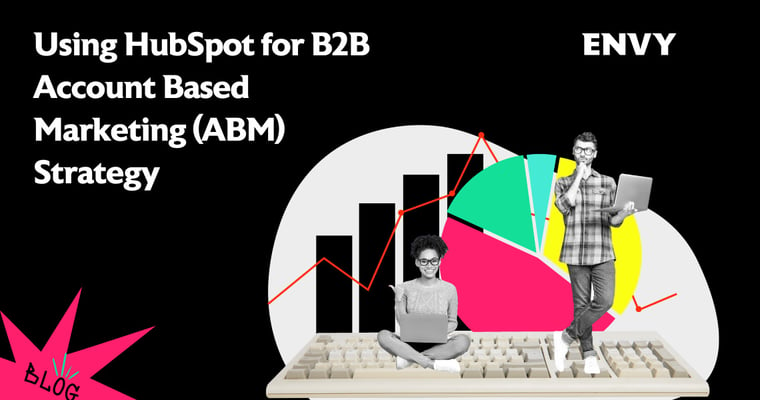
Using HubSpot for B2B Account Based Marketing (ABM)
If your sales cycle is longer than 6 months with multiple buyer groups involved, or if your ACV is pretty high but there aren't THAT many opportunities on the market, ABM is for you. And what better place to orchestrate your ABM motion than on HubSpot?
What ABM is (and isn't)
Simply put, Account Based Marketing (ABM) is an approach to B2B marketing that focuses on building engagement with specific target accounts within a market. It relies on highly personalized campaigns in order to spark interest within those accounts that are most likely to close fastest and with the highest ROI.
We've written a lot about Account Based Marketing (ABM) services by now, but probably the biggest misconception about ABM motions (that we're still hearing) is that it's a stand-alone practice. And it isn’t! ABM integrates all of your marketing stack - the market research that will help you determine the audience and its size, the content you need to create to interest your target audience, the paid and organic campaigns you’ll activate to reach them, the signals you’ll collect to empower your sales teams to engage with them, the technology that will trace, monitor, nurture and report on the KPIs.
ABM has been here for quite a while, so why the buzz around ABM now? In the "ever-evolving digital landscape..." and mass advertising (aka AI-generated ToF content), personalized communication stands out more than ever. It sharpens your messages, your content, and your overall engagement, helping your leads move through the funnel smoothly. But remember, don't think of it in terms of B2B ABM vs. traditional marketing – that's not everything.
Choosing the right tech stack to manage your ABM campaign
Figuring out what’s what amidst all the ABM tools available on the market today can feel like a trip down a rabbit hole. After all, it’s been years since the first marketing automation tool was released and some people still remain its loyal customers (we’re looking at you, Eloqua and Marketo users).
In order to maximize the potential for your Account Based Marketing, you’ll need to choose and implement a solution that can easily scale with your organization, and one that enables your marketing, sales and C-level management teams to work in unison. And for B2B marketers, HubSpot shines as the most comprehensive choice (we might be biased - we’re HubSpot Diamond Partner after all!) HubSpot understands the need for a symbiotic relationship between the three and offers an extraordinarily unified suite of tools to facilitate this harmony.
Other reasons why we love running ABM campaigns on HubSpot are:
- It’s your main source of data for all teams involved (which means you can keep your records clean and consistent);
- Due to its rich integration architecture, it can be a true hub for all buyer signals: first, second and third party;
- With its deep automation capabilities it is the perfect orchestration tool for complex motions across your revenue teams;
- It makes building (and analyzing) reports, lists and dashboards SO easy;
- Great AI advancements (HubSpot for ABM has been releasing new AI-powered features at the speed of the light to make our lives easier. It will read your reports and summarize them for you to keep track of only the essential stuff. Next step is to write those reports…);
- All content pieces and campaign assets in one place. Your landing page, email nurturing flows, blog posts, company lists, even social media posts are all there. And guess what? Once you group them together per campaign, you can even see which asset it gaining the most attribution;
- From a team activation perspective, your options are almost endless: Slack (or Teams) for improved communication within teams? Check. Clearbit for enriching your contact database? Check. LinkedIn Sales Navigator for better insights on your leads? Check!
Key components of running ABM campaigns on HubSpot
The HubSpot Account Based Marketing Paradigm is divided into different phases, including a measurement phase that’s extended throughout the campaign. We’ve written more about these stages of an ABM strategy in detail.
- Build: Your sales & marketing & C-level management alignment;
- Identify: Your ICP and target accounts;
- Create: An account plan that aligns the different departments;
- Attract: Stakeholders through engaging content across different channels;
- Monitor: Buyer signals (via a variety of tools such as 6sense, Trendemon, Leadfeeder or others);
- Engage: Your target accounts with personalized messages and assets;
- Measure: KPIs from the moment you identify target accounts, to the moment you close.
Setting up HubSpot for Account Based Marketing (ABM) campaign
So let's get straight to it. Here's how you start with your ABM on HubSpot.
Add target accounts
-1.gif?width=1920&height=850&name=Company%20name%20(1920%20x%20850%20px)-1.gif)
Target Accounts under the Contacts tab (or under Companies in the new navigation) is HubSpot’s version of an Account Based Marketing dashboard. From here, you can view campaign-related information such as:
- Accounts with open deals,
- Open deal value,
- Target accounts,
- Recommended target accounts.
This is the place where both marketing and sales teams can keep track of the accounts you want to target in your ABM, any logged calls or meetings, and their latest engagements with your campaign. Thanks to this, you’ll be able to know exactly how each target account is performing in accordance with your strategy. But before that, you’ll need to create a list of your target accounts - you can either upload an existing list, or add contacts manually.
Set up your ABM workflow
HubSpot’s ABM workflows allow you to automate operations and tasks, which help you save time and resources. The default workflow sorts companies by ideal customer profile fit, which splits your companies into three tiers:
- The first tier is companies estimated to be an ideal fit for your business,
- The second tier includes companies that still might be a good fit, but shouldn’t be your primary focus,
- The third tier means companies with lowest priority.
You can assign a tier value yourself, for example based on a company’s annual revenue value. You can also choose from different templates, like scoring companies by their ICP score (the higher match to your expectations = the higher score) which allows you to spot common traits that can later be used to classify companies in your database by how well they match your ICP.
Within all workflows, you can add internal notifications that’ll alert specific team members whenever a new company is added and should be acted on.
Set up ABM ads campaigns
Paid campaigns are essential to any Account Based Marketing strategy as they help drive leads by engaging with new audiences, and keeping existing contacts in the loop as they go through different stages of the ABM funnel. Plus, integrating your HubSpot with LinkedIn or Google Ads Manager makes managing your paid campaigns really easy.
Through HubSpot, you can use demographic information to send highly personalized messages to target accounts – even if the contacts within that account are outside of your database. From that level you can also reach your target companies with relevant messaging throughout all stages of the buyer’s journey.
Keep your ABM campaign assets in one place
.jpg?width=1920&height=850&name=Company%20name%20(1920%20x%20850%20px).jpg)
This one’s a real treat especially for the marketing folks in your ABM team, although HubSpot’s Campaigns view works great for keeping your sales team and C-level management in the loop as well. From this view, you can keep track of all the assets being used for specific campaigns, as well as the overall performance of the campaign, and attribution to individual elements.
And by the way, did you know that one of HubSpot’s latest features (currently only available for CTA tools, but should come to other areas soon) allows you to truly segment your audiences and offer different content depending on their previous interactions?
Measure ABM success metrics
As with any approach, measuring your progress is important to building and maintaining efficiency. For this reason, your Account Based Marketing campaign needs to include actionable and available results – and we recommend agreeing on what those will be as early on as possible.
Since account engagement is required to be one of the main success metrics for Account Based Marketing that both sales and marketing must adopt, your campaign should also be able to measure overall account-level engagement across specific and multiple accounts.
HubSpot makes this really easy. By measuring, analyzing, and optimizing your metrics, you’ll be able to understand your ABM campaign's revenue impact. Some of the reports available for use in Account Based Marketing campaigns include:
- Ideal customers profile tier,
- Contacts created at target accounts,
- Target accounts by page views,
- Target account totals by source,
- Buying role by target account.
One thing to add here, what makes HubSpot a powerful tool for your ABM campaigns is the integration with even more versatile platforms for intent signals, such as 6sense, G2 or even ZoomInfo or Apollo. To measure engagement and intent in detail, you might want to consider synching HubSpot with other tools for best ABM results.
Running your ABM campaign on HubSpot will offer a direct line to your most valuable leads, fostering relationships that are not only more profitable but also more sustainable. Dig into the data, personalize at scale, add the human touch, align your teams, and never stop learning.
Ready to take the lead? We’re here to help. Schedule a free consultation with one of our ABM experts and we’ll take it from there.







-2.jpg?width=352&name=B2B%20PPC%20Campaign%20Strategy%20That%20Works%20(1)-2.jpg)